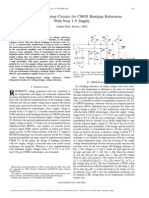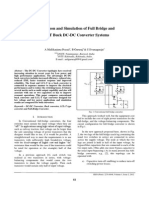A Comparator With Reduced Delay Time in 65-nm CMOS For Supply Voltages Down To 0.65 V
A Comparator With Reduced Delay Time in 65-nm CMOS For Supply Voltages Down To 0.65 V
Uploaded by
SrinivasAnchalaCopyright:
Available Formats
A Comparator With Reduced Delay Time in 65-nm CMOS For Supply Voltages Down To 0.65 V
A Comparator With Reduced Delay Time in 65-nm CMOS For Supply Voltages Down To 0.65 V
Uploaded by
SrinivasAnchalaOriginal Title
Copyright
Available Formats
Share this document
Did you find this document useful?
Is this content inappropriate?
Copyright:
Available Formats
A Comparator With Reduced Delay Time in 65-nm CMOS For Supply Voltages Down To 0.65 V
A Comparator With Reduced Delay Time in 65-nm CMOS For Supply Voltages Down To 0.65 V
Uploaded by
SrinivasAnchalaCopyright:
Available Formats
810
IEEE TRANSACTIONS ON CIRCUITS AND SYSTEMSII: EXPRESS BRIEFS, VOL. 56, NO. 11, NOVEMBER 2009
A Comparator With Reduced Delay Time in 65-nm
CMOS for Supply Voltages Down to 0.65 V
Bernhard Goll, Member, IEEE, and Horst Zimmermann, Senior Member, IEEE
AbstractA comparator in a low-power 65-nm complementary
metaloxidesemiconductor process (only standard transistors
with threshold voltage Vt 0.4 V were used) is presented, where
the circuit of a conventional latch-type comparator consisting of
two cross-coupled inverters is modified for fast operation, even
with 0.6 GHz at a low supply voltage of 0.65 V. The advantages
of a high-impedance input, rail-to-rail output swing, robustness
against the influence of mismatch, and no static power consumption are kept. To achieve a bit error rate of 109 at 1.2-V supply,
an amplitude at the input of 16.5 mV at 4 GHz has to be applied.
If the supply voltage is lowered, 12.1 mV at 0.6 GHz/0.65 V is
necessary. The power consumption of the comparator is 2.88 mW
at 5 GHz (1.2 V) and 128 W at 0.6 GHz (0.65 V). Simulations
show an offset standard deviation of about 6.1 mV at 0.65-V
supply. With an on-chip measurement circuit, the delay time of
the comparator of, e.g., 104 ps for 15-mV input amplitude at 1.2-V
supply, is obtained.
Index TermsComparator, complementary metaloxide
semiconductor (CMOS) analog circuits, low supply voltage,
modified latch, ultradeep submicrometer (UDSM) CMOS.
I. I NTRODUCTION
NALOG circuit design in ultradeep submicrometer
(UDSM) CMOS technologies suffers from low supply
voltages, thus having a small voltage headroom left, which
commonly decreases the dc performance at a given power
consumption [1]. In contrast to this, the ac performance tends
to become better in UDSM CMOS technologies due to lower
parasitic capacitances. Another problem is the increasing gate
tunnel current when the gate area is increased (supposing
optimal gm /ID ratio) to, e.g., reduce the input-referred offset.
Lowering the influence of mismatch by increasing the gate area
is limited by the gateleakage mismatch. It is now a challenge
to develop new circuit structures that either avoid a stack
of too many transistors between the supply rails, so that the
technology-given better ac performance does not degrade, or
keep the advantages of standard circuits, e.g., robustness against
the influence of noise and mismatch, or lower power consumption. An important circuit that is used for the transition from
the analog to the digital domain is the comparator. Commonly,
Manuscript received March 11, 2009; revised June 20, 2009 and August 7,
2009. First published October 9, 2009; current version published November 18,
2009. This work was supported in part by Infineon Technologies Austria AG
and in part by the Austrian BMVIT under Project Soft-RoC in FIT-IT via FFG.
This work was recommended by Associate Editor H.-S. Chen.
The authors are with the Institute of Electrodynamics, Microwave and Circuit
Engineering, Vienna University of Technology, 1040 Vienna, Austria (e-mail:
bernhard.goll@tuwien.ac.at; horst.zimmermann@ieee.org).
Color versions of one or more of the figures in this paper are available online
at http://ieeexplore.ieee.org.
Digital Object Identifier 10.1109/TCSII.2009.2030357
Fig. 1.
Widely used conventional latch-type comparator.
a comparator compares two analog input voltages and delivers
a logical value at the output, which indicates the polarity of
the input-voltage difference. Especially clocked regenerative
comparators are fundamental circuit blocks, which are mostly
based on cross-coupled inverters (latch) to force a fast decision
due to positive feedback [2]. This type of comparator is typically used in Flash analog-digital converters (ADCs) because
of their high decision speed. In ADCs, additional circuitry is
added to the comparator, e.g., a preamplifier for enhancing
the resolution [3][5] or an offset compensation block [6].
The applications of comparators are not only restricted to
Flash ADCs. A comparator based on a current-mode latch was
implemented in a 40-GBit/s demultiplexer in 1.2-V/0.11-m
CMOS technology. There, a 10-GHz clocked three-stage comparator with a bandwidth modulation technique was used to
extract every fourth bit of a 40-GBit/s data stream [7]. In [8],
a comparator was designed for an analog rank-order extractor,
and in [9], a latch-type voltage sense amplifier for a static
random-access memory is described.
A standard comparator circuit, which is widely used in circuit
design, with high-impedance input, rail-to-rail output swing,
and no static power consumption is shown in Fig. 1 [6], [9],
[10]. Before the comparison, the comparator is reset in the reset
phase (CLK = VSS , and N6 is off), where transistors P2 and P3
pull both output nodes OUT and OUT to VCo to define a start
condition and to have a valid logical level during reset. The
input voltages to be compared are applied to nodes CINP and
CINN. In the comparison phase (CLK = VCo , transistors P2
and P3 are off, and N6 is on), for the case where CINP > CINN,
the whole latch [cross-coupled inverters (N0, P0) and (N1, P1)]
will initiate regeneration when OUT has been discharged to
VCo Vtp by N3 before OUT (discharged by N2) reaches this
voltage level and P0 has turned on before P1. At this point
of time, OUT OUT is the amplified input voltage difference
1549-7747/$26.00 2009 IEEE
GOLL AND ZIMMERMANN: COMPARATOR IN 65-nm CMOS FOR SUPPLY VOLTAGES DOWN TO 0.65 V
CINP-CINN, which is initially applied to the latch for regeneration [6]. OUT is pulled to VCo , and OUT is pulled to VSS . In the
other case where CINP < CINN, the circuit works vice versa:
P1 is turned on before P0, and the latch pulls OUT to VSS and
OUT to VCo . In principle, this circuit has the advantage of good
robustness against noise and mismatch, because, among other
reasons, it can also be designed with large input transistors N2
and N3, e.g., to minimize the offset, where the larger parasitic
capacitances at their drains do not directly affect the switching
speed, which primarily depends on the load capacitances at
output nodes OUT and OUT. For example, when the latch
regenerates OUT toward VCo , then transistor N0 is turned off,
and node OUT is cut off from the parasitic capacitance at
the drain of N2. Thus, the effective load capacitance of the
latch is reduced in comparison to that of N2 and N3 directly
connected to the output nodes. Another reason for the lower
input-referred offset is the amplification of CINP-CINN for
the initial voltage difference, which causes the latch to switch
higher than in other structures (e.g., in [14]), where the input
transistors and the latch are parallel (additional parallel load
at the output nodes). Disadvantageous is the fact that, due to
the many stacked transistors, a sufficient high supply voltage is
needed for a proper delay time [11]. This may cause problems
in low-voltage UDSM CMOS, where even a stand-alone latch
(e.g., used in [11]), with its two cross-coupled inverters, suffers
from higher delay time if the supply voltage is reduced or a
low-power process with higher transistor threshold voltages is
used. For example, in Fig. 1, after the reset phase, the initial
condition of the comparison phase is OUT = OUT = VCo .
Thus, at the beginning of the decision, only transistors N0
and N1 of the latch contribute somewhat to positive feedback
until the voltage level of one output node has dropped enough
to turn on transistor P0 or P1 to start complete regeneration.
At a low supply voltage, this voltage drop only contributes a
small gatesource voltage for transistors N0 and N1, where the
gatesource voltage of P0 and P1 is also small; thus, the delay
time of the latch becomes large due to lower transconductances.
This brief describes a proposed comparator design, where the
latch of the conventional circuit in Fig. 1 has been replaced
by a new latch for low-supply-voltage operation, where the
advantages of a high-impedance input, a rail-to-rail output
swing, no static power consumption, and the indirect influence
of the parasitic capacitances of the input transistors (larger gate
area for lower offset) to the output nodes and, therefore, to the
switching speed have been kept. Furthermore, a structure with
parallel-connected input transistors as in [14] is avoided to get
a higher amplification of CINP-CINN for the initial voltage
difference, which causes the latch to flip with a lower inputreferred offset.
II. C IRCUIT D ESCRIPTION
The circuit of the proposed comparator is shown in Fig. 2. In
contrast to the conventional latch used in Fig. 1, where only N0
and N1 are initially on, the latch of the proposed comparator
is expanded into two paths between the supply rails (transistors
N0, N1, P0, P1, P4, and P5), so that, at the beginning of the
comparison phase, where both output nodes have the initial
811
Fig. 2. Proposed comparator with a modified latch.
Fig. 3. Transient simulations of the proposed comparator with an input
voltage difference of (gray case) 10 mV and (black case) 100 mV.
condition OUT = OUT = VCo (initially, internal nodes FB =
FB = VSS ), transistors N0 and N1 are turned on. However,
transistors P0 and P1 are also turned on and build, with input
transistors N2 and N3, an amplifier with a distinct working
point, which, in contrast to that in Fig. 1, contributes enough
gatesource voltage to transistors N0 and N1 at lower supply
voltages. Complete positive feedback of the latch starts when
one output node is discharged enough to turn on P4 or P5.
Regeneration is done with N0, N1, P0, and P1, where P4 and P5
help with additional amplification. To get a rail-to-rail output
swing and no static power consumption of the comparator,
one of the initial load transistors P0 or P1 is switched off,
when, during regeneration, FB or FB, respectively, is charged
to VCo . The other advantages of a high-impedance input and no
direct influence of parasitic capacitances of N2 and N3 to the
output nodes are kept. The corresponding transient simulations
of Fig. 2 can be seen in Fig. 3. A clock period is divided into two
phases: The reset phase (CLK = VSS ) is used to establish the
initial condition OUT = OUT = VCo for the following comparison phase. (CLK = VCo , VCo is the positive supply voltage
of the comparator.) During reset, transistor N6 is switched off,
and transistors P2, P3, N4, and N5 are on. Consequently, the
812
IEEE TRANSACTIONS ON CIRCUITS AND SYSTEMSII: EXPRESS BRIEFS, VOL. 56, NO. 11, NOVEMBER 2009
Fig. 4. Comparison of the decision time (50% clock edge to 50% of the final
output voltage difference OUT OUT = VCo ) of the conventional comparator with the proposed comparator, depending on the supply voltage VCo .
Fig. 5.
output nodes OUT and OUT are pulled toward VCo by P2
and P3, which causes transistors P4 and P5 to be switched
off. N4 and N5 pull both nodes FB and FB to VSS . Hence,
transistors P0 and P1 are turned on and help in pulling OUT
and OUT to the final voltage level VCo . Comparison of the
voltage at input CINP with the voltage at CINN is started when
CLK switches to voltage level VCo (comparison phase). Hence,
transistor N6 is turned on, and P2, P3, N4, and N5 are switched
off. At the very beginning, transistors P4 and P5 are switched
off, and transistors P0 and P1 work in the linear region and
build the load for an amplifier with N2 and N3. Transistors
N0 and N1 are initially on. (The comparison phase starts with
OUT = OUT = VCo and FB = FB = VSS .) If, for the input
voltage, CINP > CINN is assumed, transistor N3 pulls the
voltage level at node OUT down faster than N2 does at node
OUT. Hence, transistor P4 begins to conduct. In this initial time
period, a small amount of positive feedback is also contributed
by transistors N0 and N1. When P4 begins to conduct, node
FB is charged toward VCo (N4 and N5 are off), and complete
positive feedback is started. Transistor P1 is turned off, and P0
keeps conducting, because node OUT is pulled to VCo . Thus, P5
remains off, and FB remains near VSS . (Sufficient input voltage
difference CINP-CINN is assumed.) Finally, N1, P4, and P0 are
switched on, and N0, P1, and P5 are turned off. Thus, OUT is
at voltage level VCo , OUT is at VSS , and no static current can
flow after the decision. In the other case where CINP > CINN,
OUT is pulled to VSS , and OUT is pulled to VCo , respectively.
A comparison of the decision times at different supply voltages of the proposed comparator in Fig. 2 with those of the
conventional comparator in Fig. 1 is shown in Fig. 4. Each comparator was designed in a similar way, so that the decision time
(50% clock edge to 50% of the final output voltage difference
OUT OUT = VCo ) is equal for VCo = 1.2 V with the same
transistors N0, N1, N2, N3, and N6. For example, at a supply
voltage of VCo = 0.6 V, the proposed comparator needs only
650 ps, instead of 2.95 ns, of the conventional comparator and
is therefore capable of low-voltage operation. For test purposes,
a test chip with the proposed comparator in 65-nm low-power
CMOS technology with a nominal supply voltage of VDD =
1.2 V was designed, whose block diagram is shown in Fig. 5.
The dashed rectangle marks an area that is separately supplied
with a voltage VCo to be able to investigate the behavior of
Block diagram of the test chip with the comparator.
Fig. 6. Detailed block diagram of on-chip delay-time measurement implementation, which consists of the transfer stage at node OUT and the appropriate
output driver with low-pass filters (R0 , C0 ) and (R1 , C1 ).
the comparator if VCo is lowered. The area outside is supplied
with nominal VDD = 1.2 V to always have the functionality
of the additional measurement circuitry for the characterization
of the implemented comparator. With the help of the clock
driver, a noninverted digital clock CLK and the appropriate
inverted clock CLK are generated, where the logical voltage
levels are VSS and VCo . To generate a clock signal, a sine
wave in which the frequency is defined by the on-chip clock
frequency and the duty cycle (adjusted to 50%) is defined
by the dc bias voltage level is applied to pad CLKIN. The RC
low-pass filters (R2, C2) and (R3, C3) are added to measure the
mean voltage (duty cycle) of the internal clock lines CLK and
CLK at pads CLKAVP and CLKAVN, respectively. All highfrequency inputs CLKIN, CINP, and CINN are terminated with
on-chip 50- resistors. The transfer stage (see Figs. 5 and 6)
dynamically holds the decision of the comparator during its
reset phase at node SHB. In the case where CLK1 and CLK1
are also switched to transmission gates P7 and N8, respectively
(case DIG = 1.2 V), P7 and N8 are turned off when P6 and N7
are on, and vice versa during a clock cycle. Therefore, at outputs
COUT and COU T , a single decision of the comparator lasts for
a whole clock period, and the overall delay time between (CLK,
CLK) and (COUT, COU T ) is kept constant to simplify bit
GOLL AND ZIMMERMANN: COMPARATOR IN 65-nm CMOS FOR SUPPLY VOLTAGES DOWN TO 0.65 V
813
Fig. 8. Micrograph of the test chip with the comparator.
Fig. 7. Transient simulation to illustrate the measurement of the delay time
of the comparator (see also Fig. 6, case DIG = VSS , where P7 and N8 are
always turned on). An amplitude at the input CINP of 100 mV (black case)
causes a delay time td1 , and a smaller amplitude of 10 mV (gray case) causes a
larger delay time td2 . The delay time is then determined by measuring the mean
voltage of nodes DM0 and DM1 at D0AV and D1AV, respectively. VDM =
D0AV D1AV is proportional to td .
error rate (BER) measurements with a BER analyzer, because
the delay time of the comparator varies, depending on, e.g., the
amplitude or the common-mode voltage at the inputs. In the
transfer stage (see also Fig. 6), adapters for the conversion of
the logical voltage levels VSS and VCo to levels VSS and VDD
are added at the input. Such an adapter consists of a chain of two
inverters, where each inverter is separately supplied for stepwise increasing the supply voltage from VCo to VDD = 1.2 V.
Each output driver of Fig. 5 consists of a chain of inverters and
is able to drive off-chip 50- measurement equipment. RC lowpass filters (R0, C0) and (R1, C1) have been added at the output
driver for COU T , with which, in addition to the transfer stage,
the delay time td of the comparator at OUT can be measured
(see Fig. 6). Delay time measurements can be done in the case
where DIG = VSS when only transmission gate (P6, N7) holds
the decision of the comparator during reset and transmission
gate (P7, N8) is switched to be always turned on. The delay
time is defined here as the time duration, which begins at the
time point when the voltage level has reached 50% of VCo at
the rising edge of CLK and ends at the time point when OUT
has fallen to the switching threshold of the following inverter
( 50% of VCo ). The transient simulations for Fig. 6 to illustrate
delay-time measurements are shown in Fig. 7. For measuring
the delay time, a rectangular signal with a period of two times
the clock period, which is superimposed by a bias voltage for
offset compensation, is applied to CINP, as shown in Fig. 7.
CINN is biased with a reference voltage, e.g., an amplitude at
the input CINP of 100 mV (black case) causes a delay time
td1 , and a smaller amplitude of 10 mV (gray case) causes a
larger delay time td2 at OUT. Signal OUT is led to a chain of
inverters, which are able to drive the parasitic capacitances of
transmission gate (P6, N7). To compensate the additional delay
time, which is caused by the inverter chain, signal CLK and
CLK are each led via an equal inverter chain as well. Thus, the
time difference between turning on (P6, N7) by CLK1 and the
rising edge at node SHA is the delay time td of the comparator.
The reset time of the comparator is not considered due to the
fact that it is replaced by TCLK /2 because transmission gate
(P6, N7) holds the decision of the comparator at node SHB
during reset TCLK /2 long. Transistors P7 and N8 are always
on. Thus, the duty cycle at nodes DM0 and DM1 in the output
driver comprises information on the comparators delay time.
To obtain this delay time td , the mean voltages of DM0 and
DM1 are measured at D0AV and D1AV, and then, the following
is used:
td =
D0AV D1AV
VDM
TCLK =
TCLK .
VDD
VDD
(1)
A Monte Carlo simulation with 50 runs for the delay-time
measurement system consisting of the transfer stage and output
driver, as shown in Fig. 6, has been done, where, instead of the
output signal of the comparator, a signal with a known delay
time has been introduced to the transfer stage. As a result, an
offset error of 6 ps and a standard deviation of < 4 ps of
the simulated delay time measurement result were obtained.
It should be mentioned that the measurement technique is
independent of the duty cycle of the signal CLK.
An analytical calculation of the delay time of the comparator
itself can be done in a similar way as in [9]: The threshold
voltage of P4 (= P5), for the first part (discharging time of the
output nodes), and the additional contribution of the transconductances of (P4, P5) and the parasitic capacitances of the
internal nodes FB and FB to positive feedback, for the second
part (regeneration time of the latch), have to be considered.
III. M EASUREMENT R ESULTS
A chip with an area of 930 500 m2 was fabricated in
low-power 65-nm CMOS technology (see Fig. 8). Thereof
28.4 49.1 m2 is dedicated to the comparator.
The influence of noise to the decision of the comparator
and, thus, the sensitivity can be characterized with the help
of statistical measurements by measuring the BER with an
appropriate pattern generator and receiver. A reference voltage
(at CINN) and a pseudorandom bit sequence 231 1 (at CINP)
were applied, which was superimposed to a bias voltage of
814
IEEE TRANSACTIONS ON CIRCUITS AND SYSTEMSII: EXPRESS BRIEFS, VOL. 56, NO. 11, NOVEMBER 2009
IV. C ONCLUSION
Fig. 9. BER measurements.
A comparator with a modified latch for low-supply-voltage
operation has been fabricated in low-power 65-nm CMOS
(threshold voltage 0.4 V) and characterized with the help of
an on-chip delay-time measurement circuit. Compared to [9],
[11][13], the proposed comparator has shown a good tradeoff
between sensitivity, offset, and speed, with the big advantage
of working even at a supply voltage of 0.65 V with a clock
rate of 0.6 GHz, power consumption of 128 W, sensitivity of
12.1 mV, and simulated = 6.1 mV of the offset. On the contrary, in [12], transistors with a threshold voltage of 0.29 V
were used, and the comparator worked with 0.6 GHz at
0.5-V supply voltage with 60.5-mV sensitivity and a simulated
standard deviation of the offset = 57 mV but 18-W power
consumption. Compared to [14], the offset = 22 mV is
reduced to 1.9 mV at 1.2 V. By placing the input transistors
below the modified latch, the delay time is shortened to 650 ps,
compared with 900 ps in [14] at 0.6-V supply.
ACKNOWLEDGMENT
The authors would like to thank Infineon, Villach, Austria,
especially Ch. Sandner, L. Drrer, and A. Bertl for initiating
this work.
R EFERENCES
Fig. 10. With the help of the on-chip measurement implementation, determined mean delay time of the comparator (with ten test chip samples measured,
7 ps).
CINN + offset to compensate the offset of the comparator. The
amplitude of a bit sequence is defined here, i.e., the bits switch,
at CINP +/ amplitude, around voltage level CINN + offset,
whereas, at CINN, the reference voltage is applied. The BER
measurement results of a typical test chip are shown in Fig. 9.
To achieve BER = 109 at 1.2-V supply, an amplitude of
7.8 mV at 3 GHz, 16.5 mV at 4 GHz, and 145 mV at 5 GHz
had to be applied. If VCo was lowered, 7 mV at 1 GHz/0.75 V,
6.9 mV at 0.5 GHz/0.65 V, and 12.1 mV at 0.6 GHz/0.65 V
were measured.
The determined mean delay time of the comparator (ten chip
samples), which was measured with the on-chip measurement
implementation previously described, is shown in Fig. 10. For
an amplitude of, e.g., 15 mV, at the input of the comparator, the
mean delay times ( 7 ps) were 93 ps at CINN = 0.65 V,
104 ps at CINN = 0.6 V, and 115 ps at CINN = 0.55 V at
VCo = 1.2 V.
The power consumption of the comparator was 2.88 mW at
5 GHz (1.2 V), 295 W at 1 GHz (0.75 V), and 128 W at
0.6 GHz (0.65 V). To investigate the influence of mismatch,
Monte Carlo simulations were done. For a run of 50 samples,
the standard deviations of the offset were simulated to be
1.9 mV at CINN = 0.6 V (VCo = 1.2 V), 4 mV at CINN =
0.55 V (VCo = 0.75 V), and 6.1 mV at CINN = 0.5 V (VCo =
0.65 V).
[1] A.-J. Annema, B. Nauta, R. van Langevelde, and H. Tuinhout, Analog
circuits in ultra-deep-submicron CMOS, IEEE J. Solid-State Circuits,
vol. 40, no. 1, pp. 132143, Jan. 2005.
[2] H. J. M. Veendrick, The behavior of flip-flops used as synchronizers and
prediction of their failure rate, IEEE J. Solid-State Circuits, vol. SSC-15,
no. 2, pp. 169176, Apr. 1980.
[3] K. Uyttenhove and M. S. J. Steyaert, A 1.8-V 6-Bit 1.3-GHz flash
ADC in 0.25- m CMOS, IEEE J. Solid-State Circuits, vol. 38, no. 7,
pp. 11151122, Jul. 2003.
[4] V. Ferragina, N. Ghittori, and F. Maloberti, Low-power 6-bit flash ADC
for high-speed data converters architectures, in Proc. IEEE Int. Symp.
Circuits Syst., 2006, pp. 39303933.
[5] C. Paulus, H.-M. Blthgen, M. Lw, E. Sicheneder, N. Brls, A. Courtois,
M. Tiebout, and R. Thewes, A 4 GS/s flash ADC in 0.13 m CMOS, in
Proc. IEEE Symp. VLSI Circuits, 2004, pp. 420423.
[6] K.-L. J. Wong and C.-K. K. Yang, Offset compensation in comparators
with minimum input-referred supply noise, IEEE J. Solid-State Circuits,
vol. 39, no. 5, pp. 837840, May 2004.
[7] Y. Okaniwa, H. Tamura, M. Kibune, D. Yamazaki, T.-S. Cheung,
J. Ogawa, N. Tzartzanis, W. W. Walker, and T. Kuroda, A 40-Gb/s
CMOS clocked comparator with bandwidth modulation technique,
IEEE J. Solid-State Circuits, vol. 40, no. 8, pp. 16801687, Aug. 2005.
[8] Y.-C. Hung and B.-D. Liu, 1-V CMOS comparator for programmable
analog rank-order extractor, IEEE Trans. Circuits Syst. I, Fundam.
Theory Appl., vol. 50, no. 5, pp. 673677, May 2000.
[9] B. Wicht, T. Nirschl, and D. Schmitt-Landsiedel, Yield and speed optimization of a latch-type voltage sense amplifier, IEEE J. Solid-State
Circuits, vol. 39, no. 7, pp. 11481158, Jul. 2004.
[10] T. Kobayashi, K. Nogami, T. Shiroto, and Y. Fujimoto, A currentcontrolled latch sense amplifier and a static power-saving input buffer
for low-power architecture, IEEE J. Solid-State Circuits, vol. 28, no. 4,
pp. 523527, Apr. 1993.
[11] D. Schinkel, E. Mensink, E. Klumpernik, E. van Tuijl, and B. Nauta, A
double-tail latch-type voltage sense amplifier with 18 ps setup + hold
time, in Proc. IEEE ISSCC, 2007, pp. 314315.
[12] B. Goll and H. Zimmermann, A 0.12 m CMOS comparator requiring
0.5 V at 600 MHz and 1.5 V at 6 GHz, in Proc. IEEE ISSCC, 2007,
pp. 316317.
[13] B. Goll and H. Zimmermann, A clocked, regenerative comparator in
0.12 m CMOS with tuneable sensitivity, in Proc. ESSCIRC, 2007,
pp. 408411.
[14] B. Goll and H. Zimmermann, A 65 nm CMOS comparator with modified
latch to achieve 7 GHz/1.3 mW at 1.2 V and 700 MHz/47 W at 0.6 V,
in Proc. IEEE ISSCC, 2009, pp. 328329.
You might also like
- KodeKloud Kubernetes CKS 010 020 Intro and Cluster Setup Hardening100% (1)KodeKloud Kubernetes CKS 010 020 Intro and Cluster Setup Hardening422 pages
- A Double-Tail Latch-Type Voltage Sense Amplifier With 18ps Setup+Hold TimeNo ratings yetA Double-Tail Latch-Type Voltage Sense Amplifier With 18ps Setup+Hold Time3 pages
- WLS27 Pro Parameter Data Function BlockNo ratings yetWLS27 Pro Parameter Data Function Block15 pages
- Certified Cloud Security Professional (CCSP) : Study Guide100% (1)Certified Cloud Security Professional (CCSP) : Study Guide182 pages
- Op-Amps and Startup Circuits For CMOS Bandgap References With Near 1-V SupplyNo ratings yetOp-Amps and Startup Circuits For CMOS Bandgap References With Near 1-V Supply5 pages
- A High-Speed High-Resolution Latch Comparator For Pipeline Analog-to-Digital ConvertersNo ratings yetA High-Speed High-Resolution Latch Comparator For Pipeline Analog-to-Digital Converters4 pages
- Low Swing Signaling Using A Dynamic Diode-Connected DriverNo ratings yetLow Swing Signaling Using A Dynamic Diode-Connected Driver4 pages
- Analysis, Design, and Implementation of A High-Efficiency Full-Wave Rectifier in Standard CMOS TechnologyNo ratings yetAnalysis, Design, and Implementation of A High-Efficiency Full-Wave Rectifier in Standard CMOS Technology11 pages
- Subthreshold Source-Coupled Logic Circuits For Ultra-Low-Power ApplicationsNo ratings yetSubthreshold Source-Coupled Logic Circuits For Ultra-Low-Power Applications12 pages
- A Novel High Speed and Energy Efficient 10 Transistor Full Adder DesignNo ratings yetA Novel High Speed and Energy Efficient 10 Transistor Full Adder Design20 pages
- The Impact of Transistor Sizing On Power Efficiency in Submicron CMOS CircuitsNo ratings yetThe Impact of Transistor Sizing On Power Efficiency in Submicron CMOS Circuits4 pages
- IEEE - CMOS Transconductance Amplifiers, Architectures and Active Filters TutorialNo ratings yetIEEE - CMOS Transconductance Amplifiers, Architectures and Active Filters Tutorial10 pages
- Low-Voltage CMOS Analog Bootstrapped Switch For Sample-and-Hold Circuit: Design and Chip CharacterizationNo ratings yetLow-Voltage CMOS Analog Bootstrapped Switch For Sample-and-Hold Circuit: Design and Chip Characterization4 pages
- A Fold-Back Current Limit Circuit With Load-Insensitive Quiescent Current For CMOS Low Dropout RegulatorNo ratings yetA Fold-Back Current Limit Circuit With Load-Insensitive Quiescent Current For CMOS Low Dropout Regulator4 pages
- Simple Class A Amplifier by JL Linsley Hood Wireless World Dec 1970 Jlh1970No ratings yetSimple Class A Amplifier by JL Linsley Hood Wireless World Dec 1970 Jlh19704 pages
- Performance Very Low Frequency Filters: Design Considerations For HighNo ratings yetPerformance Very Low Frequency Filters: Design Considerations For High4 pages
- Application Note 9093, From ON SemiconductorNo ratings yetApplication Note 9093, From ON Semiconductor7 pages
- Switching Power Supply Design Review - 60 Watt Flyback Regulator by Raoji Patel and Glen FRFTZ Slup072No ratings yetSwitching Power Supply Design Review - 60 Watt Flyback Regulator by Raoji Patel and Glen FRFTZ Slup07217 pages
- Low Power High Speed I/O Interfaces in 0.18um CmosNo ratings yetLow Power High Speed I/O Interfaces in 0.18um Cmos4 pages
- An Offset Compensated Fully Differential CMOS Current ComparatorNo ratings yetAn Offset Compensated Fully Differential CMOS Current Comparator4 pages
- 0.5-V 70-nW Rail-to-Rail Operational Amplifier Using a Cross-Coupled Output StageNo ratings yet0.5-V 70-nW Rail-to-Rail Operational Amplifier Using a Cross-Coupled Output Stage5 pages
- Comparison and Simulation of Full Bridge and LCL-T Buck DC-DC Converter SystemsNo ratings yetComparison and Simulation of Full Bridge and LCL-T Buck DC-DC Converter Systems5 pages
- 2011 IEEE Source Follower Based Track and Hold CircuitNo ratings yet2011 IEEE Source Follower Based Track and Hold Circuit4 pages
- Bandwidth Enhacement by Inductor + Current FeedbackNo ratings yetBandwidth Enhacement by Inductor + Current Feedback14 pages
- Abstract: Ultra-Low Power Phase Locked LoopsNo ratings yetAbstract: Ultra-Low Power Phase Locked Loops4 pages
- Massachusetts Institute of Technology Department of Electrical Engineering and Computer ScienceNo ratings yetMassachusetts Institute of Technology Department of Electrical Engineering and Computer Science7 pages
- Static Power Reduction Techniques For Asynchronous Circuits: Carlos Ortega, Jonathan Tse, and Rajit ManoharNo ratings yetStatic Power Reduction Techniques For Asynchronous Circuits: Carlos Ortega, Jonathan Tse, and Rajit Manohar10 pages
- A Fully Differential Switched-Current Delta-Sigma Modulator Using Single 3.347 Power-Supply VoltageNo ratings yetA Fully Differential Switched-Current Delta-Sigma Modulator Using Single 3.347 Power-Supply Voltage4 pages
- Low Power CMOS Digital Circuit Design Methodologies With Reduced Voltage SwingNo ratings yetLow Power CMOS Digital Circuit Design Methodologies With Reduced Voltage Swing4 pages
- A Wide Tuning Range Voltage-Controlled Ring Oscillator Dedicated To Ultrasound TransmitterNo ratings yetA Wide Tuning Range Voltage-Controlled Ring Oscillator Dedicated To Ultrasound Transmitter4 pages
- Analysis and Design of A Low-Voltage Low-Power Double-Tail ComparatorNo ratings yetAnalysis and Design of A Low-Voltage Low-Power Double-Tail Comparator10 pages
- Reference Guide To Useful Electronic Circuits And Circuit Design Techniques - Part 1From EverandReference Guide To Useful Electronic Circuits And Circuit Design Techniques - Part 12.5/5 (3)
- Instant Download C Core Guidelines Explained Best Practices for Modern C 1st Edition Grimm PDF All Chapters100% (2)Instant Download C Core Guidelines Explained Best Practices for Modern C 1st Edition Grimm PDF All Chapters65 pages
- Lecture 19 - Single-Phase Squarewave InvertersNo ratings yetLecture 19 - Single-Phase Squarewave Inverters24 pages
- A High-Bias, Low-Variance Introduction To Machine Learning For Physicists PDFNo ratings yetA High-Bias, Low-Variance Introduction To Machine Learning For Physicists PDF117 pages
- Projeto STRIUM - Layout Escritório Kering Sistemas Especiais-InTRUSÃONo ratings yetProjeto STRIUM - Layout Escritório Kering Sistemas Especiais-InTRUSÃO1 page
- Specification Monitor Ad Notam Dfu 0133 045No ratings yetSpecification Monitor Ad Notam Dfu 0133 0453 pages
- Thermal Imaging Cameras For Optical Gas Imaging (OGI) and Furnace InspectionsNo ratings yetThermal Imaging Cameras For Optical Gas Imaging (OGI) and Furnace Inspections28 pages
- OFM Computer World accused of exploiting celebrities: Esther Smith exposes fraudulent music Industry practicesNo ratings yetOFM Computer World accused of exploiting celebrities: Esther Smith exposes fraudulent music Industry practices3 pages
- Mt6260 Gsm/Gprs/Edge-Rx Soc Processor Technical Brief (Draft)No ratings yetMt6260 Gsm/Gprs/Edge-Rx Soc Processor Technical Brief (Draft)56 pages
- AICTE - FDP-programme Schedule at ACT PDFNo ratings yetAICTE - FDP-programme Schedule at ACT PDF7 pages
- Web Based Application For Insurance Services100% (1)Web Based Application For Insurance Services61 pages
- KodeKloud Kubernetes CKS 010 020 Intro and Cluster Setup HardeningKodeKloud Kubernetes CKS 010 020 Intro and Cluster Setup Hardening
- A Double-Tail Latch-Type Voltage Sense Amplifier With 18ps Setup+Hold TimeA Double-Tail Latch-Type Voltage Sense Amplifier With 18ps Setup+Hold Time
- Certified Cloud Security Professional (CCSP) : Study GuideCertified Cloud Security Professional (CCSP) : Study Guide
- Op-Amps and Startup Circuits For CMOS Bandgap References With Near 1-V SupplyOp-Amps and Startup Circuits For CMOS Bandgap References With Near 1-V Supply
- A High-Speed High-Resolution Latch Comparator For Pipeline Analog-to-Digital ConvertersA High-Speed High-Resolution Latch Comparator For Pipeline Analog-to-Digital Converters
- Low Swing Signaling Using A Dynamic Diode-Connected DriverLow Swing Signaling Using A Dynamic Diode-Connected Driver
- Analysis, Design, and Implementation of A High-Efficiency Full-Wave Rectifier in Standard CMOS TechnologyAnalysis, Design, and Implementation of A High-Efficiency Full-Wave Rectifier in Standard CMOS Technology
- Subthreshold Source-Coupled Logic Circuits For Ultra-Low-Power ApplicationsSubthreshold Source-Coupled Logic Circuits For Ultra-Low-Power Applications
- A Novel High Speed and Energy Efficient 10 Transistor Full Adder DesignA Novel High Speed and Energy Efficient 10 Transistor Full Adder Design
- The Impact of Transistor Sizing On Power Efficiency in Submicron CMOS CircuitsThe Impact of Transistor Sizing On Power Efficiency in Submicron CMOS Circuits
- IEEE - CMOS Transconductance Amplifiers, Architectures and Active Filters TutorialIEEE - CMOS Transconductance Amplifiers, Architectures and Active Filters Tutorial
- Low-Voltage CMOS Analog Bootstrapped Switch For Sample-and-Hold Circuit: Design and Chip CharacterizationLow-Voltage CMOS Analog Bootstrapped Switch For Sample-and-Hold Circuit: Design and Chip Characterization
- A Fold-Back Current Limit Circuit With Load-Insensitive Quiescent Current For CMOS Low Dropout RegulatorA Fold-Back Current Limit Circuit With Load-Insensitive Quiescent Current For CMOS Low Dropout Regulator
- Simple Class A Amplifier by JL Linsley Hood Wireless World Dec 1970 Jlh1970Simple Class A Amplifier by JL Linsley Hood Wireless World Dec 1970 Jlh1970
- Performance Very Low Frequency Filters: Design Considerations For HighPerformance Very Low Frequency Filters: Design Considerations For High
- Switching Power Supply Design Review - 60 Watt Flyback Regulator by Raoji Patel and Glen FRFTZ Slup072Switching Power Supply Design Review - 60 Watt Flyback Regulator by Raoji Patel and Glen FRFTZ Slup072
- Low Power High Speed I/O Interfaces in 0.18um CmosLow Power High Speed I/O Interfaces in 0.18um Cmos
- An Offset Compensated Fully Differential CMOS Current ComparatorAn Offset Compensated Fully Differential CMOS Current Comparator
- 0.5-V 70-nW Rail-to-Rail Operational Amplifier Using a Cross-Coupled Output Stage0.5-V 70-nW Rail-to-Rail Operational Amplifier Using a Cross-Coupled Output Stage
- Comparison and Simulation of Full Bridge and LCL-T Buck DC-DC Converter SystemsComparison and Simulation of Full Bridge and LCL-T Buck DC-DC Converter Systems
- 2011 IEEE Source Follower Based Track and Hold Circuit2011 IEEE Source Follower Based Track and Hold Circuit
- Bandwidth Enhacement by Inductor + Current FeedbackBandwidth Enhacement by Inductor + Current Feedback
- Massachusetts Institute of Technology Department of Electrical Engineering and Computer ScienceMassachusetts Institute of Technology Department of Electrical Engineering and Computer Science
- Static Power Reduction Techniques For Asynchronous Circuits: Carlos Ortega, Jonathan Tse, and Rajit ManoharStatic Power Reduction Techniques For Asynchronous Circuits: Carlos Ortega, Jonathan Tse, and Rajit Manohar
- A Fully Differential Switched-Current Delta-Sigma Modulator Using Single 3.347 Power-Supply VoltageA Fully Differential Switched-Current Delta-Sigma Modulator Using Single 3.347 Power-Supply Voltage
- Low Power CMOS Digital Circuit Design Methodologies With Reduced Voltage SwingLow Power CMOS Digital Circuit Design Methodologies With Reduced Voltage Swing
- A Wide Tuning Range Voltage-Controlled Ring Oscillator Dedicated To Ultrasound TransmitterA Wide Tuning Range Voltage-Controlled Ring Oscillator Dedicated To Ultrasound Transmitter
- Analysis and Design of A Low-Voltage Low-Power Double-Tail ComparatorAnalysis and Design of A Low-Voltage Low-Power Double-Tail Comparator
- Reference Guide To Useful Electronic Circuits And Circuit Design Techniques - Part 1From EverandReference Guide To Useful Electronic Circuits And Circuit Design Techniques - Part 1
- Instant Download C Core Guidelines Explained Best Practices for Modern C 1st Edition Grimm PDF All ChaptersInstant Download C Core Guidelines Explained Best Practices for Modern C 1st Edition Grimm PDF All Chapters
- A High-Bias, Low-Variance Introduction To Machine Learning For Physicists PDFA High-Bias, Low-Variance Introduction To Machine Learning For Physicists PDF
- Projeto STRIUM - Layout Escritório Kering Sistemas Especiais-InTRUSÃOProjeto STRIUM - Layout Escritório Kering Sistemas Especiais-InTRUSÃO
- Thermal Imaging Cameras For Optical Gas Imaging (OGI) and Furnace InspectionsThermal Imaging Cameras For Optical Gas Imaging (OGI) and Furnace Inspections
- OFM Computer World accused of exploiting celebrities: Esther Smith exposes fraudulent music Industry practicesOFM Computer World accused of exploiting celebrities: Esther Smith exposes fraudulent music Industry practices
- Mt6260 Gsm/Gprs/Edge-Rx Soc Processor Technical Brief (Draft)Mt6260 Gsm/Gprs/Edge-Rx Soc Processor Technical Brief (Draft)

























































































